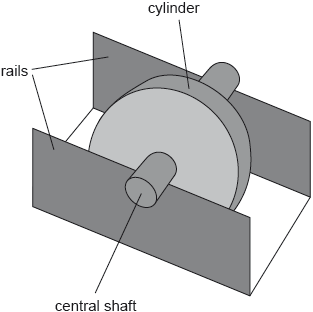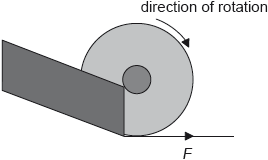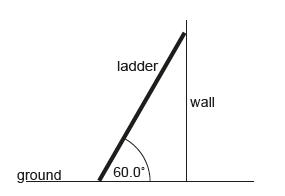A wheel of mass 0.25 kg consists of a cylinder mounted on a central shaft. The shaft has a radius of 1.2 cm and the cylinder has a radius of 4.0 cm. The shaft rests on two rails with the cylinder able to spin freely between the rails.

The stationary wheel is released from rest and rolls down a slope with the shaft rolling on the rails without slipping from point A to point B.

The wheel leaves the rails at point B and travels along the flat track to point C. For a short time the wheel slips and a frictional force F exists on the edge of the wheel as shown.

a.i.The moment of inertia of the wheel is 1.3 × 10–4 kg m2. Outline what is meant by the moment of inertia.[1]
▶️Answer/Explanation
Markscheme
a.i.
an object’s resistance to change in rotational motion
OR
equivalent of mass in rotational equations
OWTTE
[1 mark]
ΔKE + Δrotational KE = ΔGPE
OR
\(\frac{1}{2}\)mv2 + \(\frac{1}{2}\)I\(\frac{{{v^2}}}{{{r^2}}}\) = mgh
\(\frac{1}{2}\) × 0.250 × v2 + \(\frac{1}{2}\) × 1.3 × 10–4 × \(\frac{{{v^2}}}{{1.44 \times {{10}^{ – 4}}}}\) = 0.250 × 9.81 × 0.36
v = 1.2 «m s–1»
[3 marks]
ω «= \(\frac{{1.2}}{{0.012}}\)» = 100 «rad s–1»
[1 mark]
force in direction of motion
so linear speed increases
[2 marks]
force gives rise to anticlockwise/opposing torque on
wheel ✓ so angular speed decreases ✓
OWTTE
[2 marks]
Question
A uniform ladder of weight 50.0 N and length 4.00 m is placed against a frictionless wall making an angle of 60.0° with the ground.

a. Outline why the normal force acting on the ladder at the point of contact with the wall is equal to the frictional force F between the ladder and the ground. [1]
b. Calculate F. [2]
c. The coefficient of friction between the ladder and the ground is 0.400. Determine whether the ladder will slip. [2]
▶️Answer/Explanation
Ans:
a. «translational equilibrium demands that the» resultant force in the horizontal direction must be zero✔
«hence NW = F»
Equality of forces is given, look for reason why.
b.
«clockwise moments = anticlockwise moments»
50 × 2cos 60 = NW × 4sin 60 ✔
«»
F = 14.4«N» ✔
c.
maximum friction force = «0.4 × 50N» = 20«N» ✔
14.4 < 20 AND so will not slip ✔